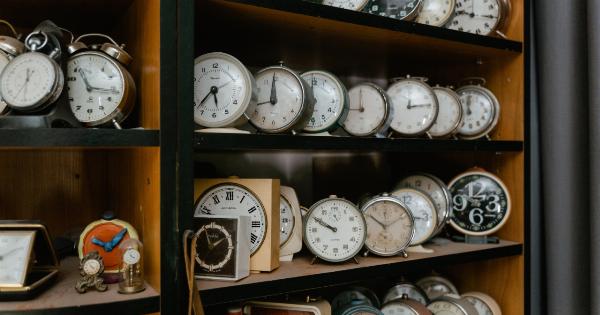Do you often feel tired and groggy during the day, but find yourself wide awake when it’s time to go to bed? You’re not alone.
Most people have two internal clocks that work together to regulate their sleep-wake cycle, and understanding how these clocks work can help you improve your sleep and overall health.
What Are Your Two Internal Clocks?
Your body has two internal clocks: the circadian rhythm and the homeostatic sleep drive.
The Circadian Rhythm
The circadian rhythm is your body’s 24-hour clock, which regulates your sleep-wake cycle, as well as other bodily functions, such as hormone release, body temperature, and digestion.
It is controlled by a cluster of cells in the brain’s hypothalamus called the suprachiasmatic nucleus (SCN).
The Homeostatic Sleep Drive
The homeostatic sleep drive is your body’s need for sleep, which increases as you stay awake and decreases as you sleep. It is regulated by a chemical called adenosine, which builds up in your brain as you stay awake and decreases as you sleep.
How Do Your Internal Clocks Work Together?
The circadian rhythm and the homeostatic sleep drive work together to regulate your sleep-wake cycle.
The Morning Rise of Cortisol
In the morning, the circadian rhythm signals your body to increase the release of cortisol, a hormone that makes you feel awake and alert.
At the same time, the homeostatic sleep drive has decreased, making it easier for you to wake up and feel refreshed.
The Afternoon Slump
In the afternoon, your circadian rhythm and homeostatic sleep drive work against each other, causing a dip in energy and alertness. It’s a good time for a power nap to recharge your batteries.
The Nighttime Sleepiness
As the day wears on, your circadian rhythm signals your body to produce melatonin, a hormone that makes you feel drowsy and ready for sleep. At the same time, your homeostatic sleep drive is at its highest, telling your body that it needs sleep.
What Happens When Your Internal Clocks Are Out of Sync?
When your internal clocks are out of sync, you may experience sleep problems, such as insomnia, daytime sleepiness, and jet lag.
Insomnia
Insomnia is a common sleep disorder characterized by difficulty falling asleep or staying asleep, or waking up too early.
It can be caused by a variety of factors, including stress, anxiety, depression, health problems, medications, caffeine, alcohol, and poor sleep habits. When your internal clocks are out of sync, your body may not produce enough cortisol in the morning, making it harder for you to wake up and feel alert.
At the same time, your body may produce too much cortisol in the evening, making it harder for you to fall asleep.
Daytime Sleepiness
Daytime sleepiness is a common symptom of sleep deprivation, sleep apnea, narcolepsy, and other sleep disorders. When your internal clocks are out of sync, you may feel tired and groggy during the day, even if you slept for a full eight hours.
This can affect your mood, productivity, and safety, especially if you drive or operate machinery.
Jet Lag
Jet lag is a sleep disorder caused by traveling across time zones, which disrupts your circadian rhythm and homeostatic sleep drive.
When you fly eastward, you lose time, causing your body to produce melatonin later than usual, making it harder for you to fall asleep and wake up earlier. When you fly westward, you gain time, causing your body to produce melatonin earlier than usual, making it easier for you to fall asleep and wake up later.
How Can You Reset Your Internal Clocks?
If your internal clocks are out of sync, you can reset them by following these tips:.
Stick to a Regular Sleep Schedule
Go to bed and wake up at the same time every day, even on weekends and holidays, to reinforce your circadian rhythm and homeostatic sleep drive. Avoid napping during the day, especially in the afternoon, to avoid disrupting your nighttime sleep.
Expose Yourself to Bright Light
Expose yourself to bright light in the morning and avoid bright light in the evening to reset your circadian rhythm. Use a light box, go outside, or open your curtains to expose yourself to natural light in the morning.
Dim your lights, turn off your TV and computer, and use blackout curtains to avoid exposure to blue light in the evening.
Avoid Stimulants Near Bedtime
Avoid caffeine, nicotine, alcohol, and stimulating activities, such as exercise, watching TV, and using your computer or phone, before bedtime. These can interfere with your sleep quality and make it harder to fall asleep and stay asleep.
Create a Sleep-Conducive Environment
Create a comfortable and relaxing sleep environment that promotes sleep. Use a comfortable mattress and pillows, keep your bedroom cool and dark, and eliminate noise and distractions, such as pets, children, and electronics.
Use Sleep Aids as a Last Resort
Use sleep aids, such as melatonin, prescription drugs, and over-the-counter remedies, as a last resort, and only under the guidance of your doctor.
These can have side effects, such as dizziness, drowsiness, and rebound insomnia, and can interfere with your natural sleep processes.
The Bottom Line
Your internal clocks play a crucial role in regulating your sleep-wake cycle, and understanding how they work can help you improve your sleep and overall health.
Reset your internal clocks by sticking to a regular sleep schedule, exposing yourself to bright light, avoiding stimulants near bedtime, creating a sleep-conducive environment, and using sleep aids as a last resort.





























